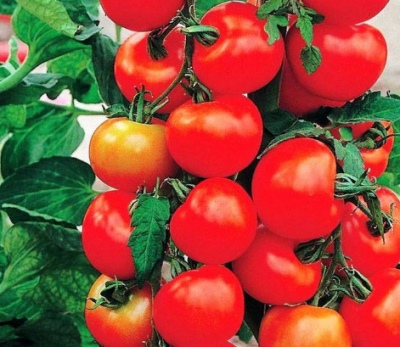
- Authors: Gavrish Sergey Fedorovich, Morev Viktor Vasilievich, Amcheslavskaya Elena Valentinovna, Volok Olga Anatolyevna, Korol Valentin Grigorievich, Gavrish Fedor Sergeevich, Scientific Research Institute of Vegetable Breeding
- Year of approval: 2004
- Category: hybrid
- Growth type: indeterminate
- Ripening period: mid-season
- Ripening time, days: 104-115
- Growing conditions: for indoor
- Marketable fruit yield,%: 98-100
- Branchiness: medium
- Foliage: medium
The Alhambra hybrid is a great indoor planting option. Even beginners can grow it, since it does not require special care, at the same time, it has excellent immunity to some common diseases.
Description of the variety
By the type of growth, this variety is classified as indeterminate. During the formation of a bush, one stem with an average foliage is laid. The foliage is dark green, matte, medium size.
The inflorescence of the Alhambra is simple, the first is laid above the 9th leaf, all the others are laid every three leaves.
This variety requires pinching, it must be tied up and shaped.
The main qualities of the fruit
One of the advantages of the Alhambra is a high yield of marketable fruits. This figure ranges from 98 to 100%.
In an unripe form, the fruits, like most tomatoes, are green. When ripe, they turn red. Alhambra tomatoes are medium in size, weighing from 142 to 170 grams. They are flat-round in shape and have weak ribbing.
In one brush, 4 or more tomatoes are formed. Moreover, the fruits of this variety are characterized by high keeping quality.
Taste characteristics
The taste of the Alhambra tomato can be described as excellent.
Ripening and fruiting
The mid-ripening period assumes from 104 to 115 days from the moment of planting the seeds to the ripening of vegetables. The harvest can begin in June, the harvest period lasts until October.
Yield
The yield level is 28.4-37.9 kg / sq. m. The described variety is productive.
The timing of planting seedlings and planting in the ground
If the Alhambra tomato is supposed to be grown in a greenhouse, then the seeds should be planted from January to March. Indoors, seeds are laid from March to April.
Seedlings can be planted after 45 days.

Growing tomato seedlings is an extremely important process, because it largely depends on whether the gardener can harvest at all. All aspects must be taken into account, from seedbed preparation to planting in the ground.
Landing scheme
Seeds are planted according to the scheme 40x50 cm.

Growing and caring
Fertile soil is suitable for planting seeds. Landing is carried out in containers to a depth of no more than 5 cm. The earth is watered abundantly, then covered with foil.When the first shoots appear, the film is removed to provide the plants with the required amount of light.
When the seedlings are ready for planting, holes are made a little larger than the root ball. Be sure to watered. In general, Alhambra tomatoes have a special attitude to watering, the soil should remain moist, but not dry out. Waterlogging should not be allowed either, since in this case the likelihood of mold and rot increases.
While the tomato bushes are growing, remove the lower leaves and stepsons. The former are the main cause of the spread of fungal diseases, the latter draw on nutrients and moisture, but at the same time do not produce high-quality fruits.
The alhambra is tied to stakes so that when the fruit is poured, the bushes do not fall.
As for dressings, at first, a large amount of nitrogen is introduced. It helps to take root, develop stems and shoots. When flowering appears, fertilizers with nitrogen cease to be applied, potash and phosphorus mixtures begin to be used. Such compositions help to improve the quality of tomatoes, give the necessary immunity from diseases.




A plant needs different micronutrients at each stage of growth. All fertilizers can be divided into two groups: mineral and organic. Folk remedies are often used: iodine, yeast, bird droppings, eggshells.
It is important to observe the rate and period of feeding. This also applies to folk remedies and organic fertilizers.
Disease and pest resistance
This variety has good resistance to the following diseases:
cladosporia;
tobacco mosaic;
fusarium wilting.
Time-tested fungicides based on sulfur and magnesium help with other diseases.
Folk remedies help well against pests: neem oil and garlic infusion. If insects cannot be dealt with, it is better to use insecticides.


Resistant to adverse weather conditions
When planting in the ground, the variety needs shelter, so it is grown in greenhouses.
Growing regions
The central region of our country is ideal for planting the described variety.

























































































